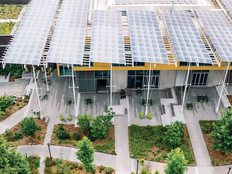4 Innovative Internet of Things Applications on the Horizon
To a creative mind, the Internet of Things (IoT) is a world of limitless potential. Devices that gather data, talk to each other and can be controlled remotely now outnumber humans on our planet, and higher education institutions are embracing the possibilities.
In an interview with EDUCAUSE Review, TJ Costello, Cisco’s director of IoT for the U.S. public sector, says that it is an exciting time for universities to innovate in IoT. “Campuses can often be viewed like cities, and some of the greatest IoT innovations today are found in ‘smart cities,’” he says. “Higher education institutions can learn from leading smart city innovators: they can transform into fully connected campuses, or they can play the role of the independent third party to help enable smart city initiatives.”
Although campus operations are the most common usage for IoT — services like building and utility management and campus security — many colleges and universities are taking IoT usage to the next level.
They’re using IoT to enhance teaching and learning, connect with their communities and manage campus life more efficiently.
SIGN UP: Get more news from the EdTech newsletter in your inbox every two weeks!
1. Leverage Connectivity to Boost Efficient Use of Resources
Microsoft’s blog reported that students and faculty at Drenthe College, an 11,000-student institution in the Netherlands, were having trouble finding empty classroom space to meet and study, even though 35 percent of classroom spaces were empty at almost all times.
To solve the issue, the college installed more than 500 Bluetooth-enabled sensors throughout campus to detect and report empty rooms.
This data not only provides room-seekers real-time information on which rooms are free, it also feeds through an artificial intelligence application to predict which rooms might be available in the future, allowing for advance scheduling.
Overall, the school estimates it’s saved nearly $164,000 in energy costs a year by efficiently utilizing room space.
2. Open Avenues for Social Change With IoT Tools
In partnership with Verizon, Babson College’s IoT for Good Lab encourages students to create IoT applications and devices to achieve UN Sustainable Development Goals, like reducing poverty and hunger and promoting good health and economic opportunities.
In Cleveland, Case Western Reserve and Cleveland State universities created the IoT Collaborative. Sponsored by a variety of public and private entities, the collaborative is developing smart solutions to issues, such as sensing groundwater and addressing Cleveland’s opioid crisis.
3. Look Beyond the Classroom to Improve Teaching
CHARIOT, the Center for Human Applied Reasoning and the Internet of Things at the University of Southern California, is a vital source for research on how IoT devices can improve teaching and learning.
Students and faculty are focused on creating tools to personalize education, such as a system that uses wristband sensors and video cameras to collect data to report students’ cognitive-emotional states in real time.
The goal is to help teachers adapt their instruction based on students’ states of mind.
4. Inspire the Creation of Revolutionary IoT Consumer Products
At Carnegie Mellon University’s Integrated Innovation Institute, students have invented futuristic products like the Connected at the Hippo. The set of two plush toys interact with each other and with humans, helping loved ones keep in touch with children or grandchildren when they’re apart.
Another prototype product is the Revenge Cycle, which helps improve commuter safety by detecting when cars are too close to bicycles, spraying the vehicle with washable paint.









